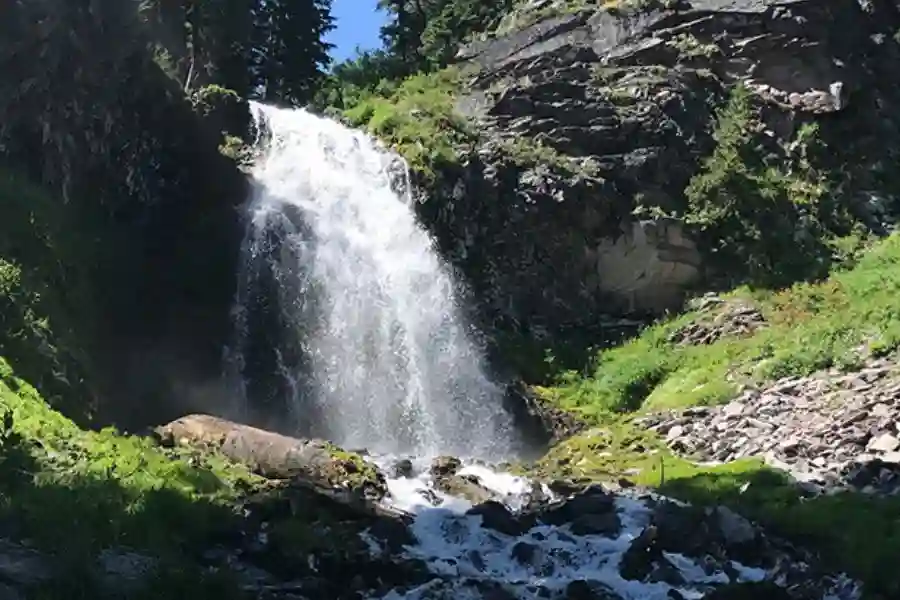If you think Oregon is just about the coast and the Columbia River Gorge, you might be missing one of the state’s best-kept secrets: waterfalls in Klamath Falls Oregon. Nestled in the southern region of the state near the California border, Klamath Falls—affectionately known as K Falls—offers an unforgettable blend of cascading waterfalls, high desert climate, and alpine forest scenery that rivals the most popular Pacific Northwest destinations.
Whether you’re a resident, road tripper, or first-time explorer wondering, “Where is Klamath Falls, and what’s worth seeing there?”—this guide is for you.
Key Takeaways:
- Discover 10 must-visit waterfalls near Klamath Falls and how to get to them.
- Learn about the best hikes in Klamath Falls that lead to stunning waterfalls.
- Find out the best time to visit and what gear to pack.
- Explore hidden gems and off-the-beaten-path locations.
- Get local tips and resources for planning your trip.
Why Visit Waterfalls in Klamath Falls Oregon?
Klamath Falls may not be the first name that pops up when you think about Oregon’s natural attractions, but it’s packed with outdoor treasures. Thanks to its unique high-elevation plateau, volcanic history, and diverse ecosystem, the region supports a surprising number of waterfalls, ranging from thundering cascades to gentle alpine trickles.
Some highlights that make Klamath Falls waterfalls special:
- Less crowded than other Oregon destinations
- Year-round access, especially in spring and early summer when water flow is highest
- Proximity to Crater Lake National Park, a must-see on its own
- Great combination of easy access spots and backcountry hikes
“Klamath Falls is Oregon’s outdoor playground with far fewer crowds than the Willamette Valley or the Gorge.” — Oregon Outdoor Recreation Coalition.
Top 10 Waterfalls Near Klamath Falls, Oregon
Here are some of the most stunning Klamath Falls waterfalls worth exploring:
Mill Creek Falls
Location: Prospect State Scenic Viewpoint (Approx. 1.5 hours from Klamath Falls)
Height: 173 feet
Trail Length: 0.8 miles round trip
Towering dramatically above the Rogue River Gorge, Mill Creek Falls plunges in a breathtaking vertical drop surrounded by thick forests and rugged volcanic cliffs. The short, scenic hike takes you through a pine-scented trail, opening up to a panoramic viewpoint perfect for photos. It’s an easy adventure with stunning rewards.
Barr Creek Falls
Next to: Mill Creek Falls
Height: Total drop of 240 feet over three distinct tiers
Just a stone’s throw from Mill Creek Falls, Barr Creek Falls cascades in three elegant stages through a deep canyon. The best time to visit is in spring when the melting snow boosts the water volume, turning it into a roaring spectacle. A small overlook lets you soak in the full beauty of this hidden gem.
Stuart Falls
Trailhead: Crater Lake National Park
Trail Length: 8.4 miles round trip
Tucked away in a quiet forested canyon, Stuart Falls is a tranquil destination that rewards hikers with solitude and beauty. The moderately challenging trail weaves through old-growth trees, wildflower meadows, and rugged terrain, making it a favorite for nature lovers seeking an off-the-beaten-path experience.
Duwee Falls
Height: 100 feet
Location: Near Crater Lake Lodge
Easily visible from Rim Drive, Duwee Falls pours down a dramatic cliff with Mount Mazama as its backdrop. Its setting within Crater Lake National Park adds to the magic—on clear days, the falls sparkle under the high-elevation sunlight. Be sure to check if Rim Drive is open, especially in early summer or late fall.
Vidae Falls
Access: Roadside stop inside Crater Lake National Park
This charming cascade tumbles down a mossy slope right beside the road, making it one of the most accessible—and photogenic—waterfalls in southern Oregon. Surrounded by wildflowers in the warmer months, Vidae Falls is a must-see snapshot of alpine serenity.
Toketee Falls (Bonus Trip)
Drive Time: About 2.5 hours from Klamath Falls
Carved through ancient basalt columns, Toketee Falls delivers a powerful two-tiered drop into a blue-green pool below. The short trail includes a scenic bridge and viewing platform, offering one of the most iconic and rewarding waterfall views in the Pacific Northwest. Its steady year-round flow makes it a dependable favorite.
Clearwater Falls
Location: Just off Hwy 138
Perfect for families or travelers short on time, Clearwater Falls is a gentle cascade flowing through a mossy, forested setting. The nearby picnic area and easy access make this a wonderful rest stop or day-use destination. Great for all ages and especially beautiful during the autumn foliage.
National Creek Falls
Setting: Remote forest location
One of the lesser-known but truly striking waterfalls in the region, National Creek Falls features a two-part drop framed by lush greenery. Reaching it involves a short but rugged trail, making it feel like a secret spot just waiting to be discovered, especially in the spring when the flow is strongest.
Pearson Falls
Location: Near Prospect, Oregon
Trail Length: 0.4 miles round trip
Don’t let its small size fool you—Pearsony Falls offers a peaceful escape with gentle cascades flowing over mossy rocks. The short, easy trail is perfect for children, beginners, or anyone looking for a quick dose of nature. Look for the interpretive signs along the way to learn more about the area’s ecology.
Location: Right in Klamath Falls
A rare urban waterfall tucked inside one of the city’s most beloved parks, this year-round cascade is a perfect place for a midday walk or picnic. Surrounded by native plants and accessible via paved trails, it’s a local treasure that brings the wild beauty of the region right into town.
Best Time to Visit Waterfalls in Klamath Falls
The ideal time to explore waterfalls in Klamath Falls is between late April and early July. This period captures snowmelt-driven runoff that boosts waterfall flow while trails remain accessible.
- Spring (April–June): Peak waterfall season
- Summer (July–August): Accessible but lower flow
- Fall (Sept–Oct): Colorful foliage, variable water
- Winter (Nov–March): Some areas may be inaccessible due to snow
Pro Tip: Always check trail conditions and wildfire updates at Oregon State Parks or the National Park Service.
What to Pack for a Waterfall Adventure?
Waterfall hiking is a blend of light trekking, moisture, and scenic views, so gear up accordingly.
Essential Gear Checklist:
- Waterproof hiking boots
- Daypack with hydration reservoir
- Light rain jacket or windbreaker
- Trail snacks and electrolytes
- Trekking poles for uneven trails camera or a smartphone for photos
- Trail map or GPS app (AllTrails recommended)
Hikes in Klamath Falls That Lead to Waterfalls
Looking for more than just a drive-by view? These hikes in Klamath Falls offer immersive waterfall experiences:
Moore Mountain Trail
- Over 20 miles of interconnecting trails
- Several segments pass creeks and waterfalls
- Great for trail runners and mountain bikers, too
Link River Trail
- Urban hike connecting Lake Ewauna and Upper Klamath Lake
- Peaceful sounds of rushing water year-round
Pacific Crest Trail (Section by Crater Lake)
- An iconic U.S. trail that passes by Stuart Falls
- Requires good fitness and navigation skills
What to See in Klamath Falls Besides Waterfalls?
Beyond the waterfalls, Klamath Falls offers a rich blend of outdoor adventure, cultural discovery, and historical depth that makes it much more than just a scenic stop. Whether you’re into wildlife, history, or just exploring the soul of a small town, here are some must-see highlights:
Crater Lake National Park: Located just about an hour’s drive from town, this iconic park is home to the deepest lake in the United States, formed by the collapse of Mount Mazama nearly 7,700 years ago. With its impossibly blue water, dramatic caldera cliffs, and rim-side hikes, Crater Lake is a surreal experience in any season.
Klamath Lake: Spanning over 90,000 acres, Klamath Lake is the largest freshwater lake in Oregon and a haven for outdoor lovers. From kayaking in its calm waters to catching a legendary Klamath trout, the lake provides ample recreation opportunities.
Upper Klamath Wildlife Refuge: Known as one of the premier birdwatching destinations in the western United States, this refuge shelters hundreds of species, including bald eagles, sandhill cranes, and pelicans. Paddle through its winding water trails by canoe or take a guided tour to learn more about the region’s delicate wetland ecosystems.
Downtown Klamath Falls: The heart of the city pulses with character, thanks to preserved Art Deco and early 20th-century architecture, locally-owned shops, coffeehouses, and galleries. From the murals that adorn alley walls to small theaters hosting live music and film festivals, downtown offers a creative and welcoming atmosphere.
Klamath County Museum: Housed in a historic 1935 National Guard Armory, this museum provides a deep dive into the Klamath Basin’s human and natural history. Exhibits highlight the traditions of the Klamath Tribes, early pioneer settlements, World War II history—including the only civilian casualties of the war on U.S. soil—and the rich volcanic geology of the region.
Conclusion
If you’re looking to escape the crowds and immerse yourself in natural beauty, the waterfalls in Klamath Falls Oregon, deliver in every season. From the iconic Mill Creek Falls to the hidden gems near Moore Park, this area is a waterfall chaser’s paradise waiting to be explored.
Which waterfall will you visit first? Will you take the scenic route or go off the grid? Explore more of Klamath Falls and its outdoor treasures by checking out our complete guide to things to do in Klamath Falls, Oregon.

